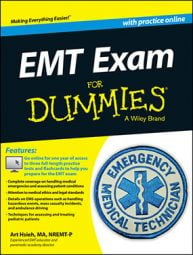There is a clear set of medical legal guidelines you should always practice and be familiar with for the EMT exam. Ethics is always important when dealing with patients. Remember that the law will either protect you or, if you do the wrong thing, provide patients the ability to be compensated for their losses as a result of your actions.
Get the proper consent
You must establish the right to render care to the patient. This can be expressed consent, where the patient is able to indicate he wants your help. Or, it can be implied consent, when the patient is unconscious or otherwise incapacitated and it would be reasonable to ask for help.
Only adults are capable of providing consent; children must be judged by the legal system to be emancipated minors in order to give consent. Adults who are unable to determine their own medical care may have a court authorize another adult to act on their behalf. The person making such decisions has durable power of attorney.
If you don’t obtain consent and proceed to treat and/or transport, you may end up being accused of battery (touching the patient without consent) or false imprisonment (kidnapping or holding someone against his will). If you threaten a patient or otherwise make the patient fearful of possible bodily harm, you are committing assault.
Understanding slander and libel
Speaking poorly about someone’s character is known as slander. Writing poorly about someone’s character is libel. For example, stating that a patient is “just drunk” to a receiving nurse could be seen as a slanderous statement; documenting that the patient was “drunk” or “intoxicated” can be seen as a libelous statement.
Deal with refusals of care and/or transport
An adult, under most circumstances, has the right to refuse your treatment and transport. You have to determine whether the person is capable of making such a decision. This includes determining whether the patient is alert, oriented, and understands the consequences of not accepting your care. You also have to assess whether any existing circumstances are impairing the patient’s judgment, such as intoxication or a language barrier.
Documentation is crucial in patient refusals. It includes having the patient sign a form that affirms her right to refuse further treatment and, in many circumstances, the signature of a witness that verifies the patient did sign the form.
Maintain confidentiality
You are required to protect the patient’s right to privacy in matters related to treatment and personal information. Federal law known as the Health Insurance Portability and Accountability Act (HIPAA) sets strict guidelines (and financial penalties!) regarding who you can share information with, which is usually limited to other medical professionals directly involved with the patient’s care.
This means no talking about private patient information to other crew members or your family or friends, as well as doctors and nurses in the hospital who will not be providing care to the patient. The patient has to authorize the sharing of information with a signed release form.
Respect advanced directives
Patients with terminal illnesses may legally request that no “heroic” or aggressive interventions be done if they die, or are dying from, that illness. The request is in written form and is generically known as a “do not resuscitate” (DNR) directive.
DNR doesn’t mean you shouldn’t treat the patient at all. You may still be required to provide supportive care and comfort. You may also need to start resuscitation during a cardiac arrest when the DNR paperwork is not available. Check with local and state policies and procedures to find out what you should do.
Steering clear of abandonment
Once you have established contact with your patient, you are obligated to stay with the patient until you release the care to an equal or higher medical authority. This person may be a paramedic who intercepts your unit or the nurse at an emergency department.
Releasing a patient includes making a verbal report with the person who is receiving your patient and following up with a written report. If you fail to do so, you may be liable for abandoning your patient.
Comply with mandatory reporting
In most states, there are laws that protect the health and welfare of children and so-called dependent adults, usually older patients and adults who are unable to make independent decisions. As an EMT, you’re required to report suspected cases of abuse or neglect to specific departments, such as child or adult protective services. Immunity from prosecution is provided to protect you in case your suspicions turn out to be inaccurate.
You may be obligated to make a report in other situations as well, such as criminal circumstances like rape or domestic violence, or special clinical scenarios such as at-home births. These vary from one state to the next. Your instructor should provide you information that is relevant in the area where you will be practicing; check state regulations regarding your role as a mandated reporter.
Cope with crime scenes
EMTs often respond to situations where a violent crime has been committed, such as physical assaults, shootings, or stabbings. Your priority is to treat the patient to the best of your abilities; while doing so, try to avoid contaminating scene evidence as much as you can.
For example, try not to cut through bullet or knife holes in clothing as you take it off the patient. Do not pick up anything in the area that you don’t absolutely need to, including any items you may discard such as plastic wrappers on cervical collars. Do your best to avoid disturbing the scene. Your local police will be very appreciative.

